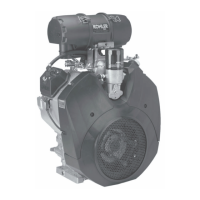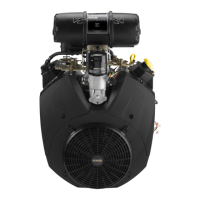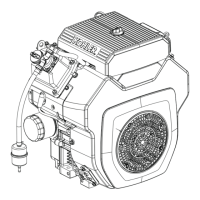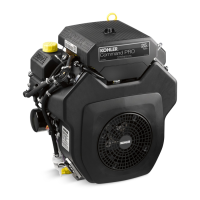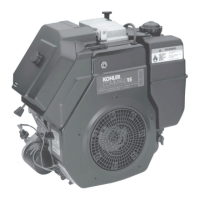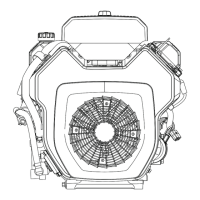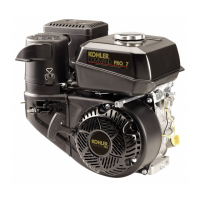Fuel System and Governor
2562 690 01 Rev. C KohlerEngines.com
6. Remove screw securing fl at washer and ground lead
(if equipped), from top of carburetor; then carefully
pull (lift) out two slow jets. Slow jets may be sized/
side specifi c. Mark or tag jets for proper reassembly.
Note small O-ring on bottom of each jet. Save parts
for cleaning and reuse unless a Jet Kit is also being
installed. Clean slow jets using compressed air. Do
not use wire or carburetor cleaner.
7. Remove idle speed (RPM) adjustment screw and
spring from carburetor. Discard parts.
Carburetor is now disassembled for appropriate
cleaning and installation of parts in overhaul kit.
Further disassembly is not necessary. Throttle shaft
assembly, fuel inlet seat, idle fuel adjustment screws
with limiter, and carburetor body, are non-serviceable
items and should not be removed. Choke shaft
assembly is serviceable, however it should not be
removed unless a Choke Repair Kit will be installed.
To service the choke shaft, continue following
overhaul procedure. Otherwise skip to step 18.
8. Remove and discard plastic cap from end of choke
lever/shaft assembly.
9. Note position of spring legs and choke plate for
correct reassembly later. Remove two screws
attaching choke plate to choke shaft. Pull shaft out of
carburetor body, note preload of spring and discard
removed parts.
10. Use a screw extractor (easy-out) and remove
original choke shaft bushing with old choke lever
from carburetor housing. Save bushing to use as a
driver for installing new bushing. Discard old lever.
11. Clean I.D. of both choke shaft bores as required.
12. Insert new bushing through new choke lever from
outside, and start bushing in outer shaft bore.
Position choke lever so protruding boss on
carburetor housing is between two stops formed in
choke lever.
13. Turn old bushing upside down and use it as a driver
to carefully press or tap new bushing into carburetor
body until it bottoms. Check that choke lever pivots
freely without restriction or binding.
14. Install new return spring onto new choke shaft, so
outboard leg of spring is behind formed stop on end
of choke shaft.
Make sure it stays in this location during following
step.
15. Slide choke shaft and spring into carburetor. Pivot
(preload) shaft 3/4 turn counterclockwise with inner
leg of spring against formed stop within choke lever
as originally assembled. Outer leg of spring must still
be behind formed stop of choke shaft.
16. Place a drop of Loctite® 222MS™ on threads of
each new screw. Position and install new choke
plate to fl at side of choke shaft. Start two screws.
Close choke and check plate alignment within
carburetor throat, then tighten screws securely. Do
not overtighten.
17. Check for proper operation and free movement of
parts. Install new cap.
Carburetor Servicing
WARNING
Accidental Starts can cause severe injury or
death.
Disconnect and ground spark plug lead(s)
before servicing.
Before working on engine or equipment, disable
engine as follows: 1) Disconnect spark plug lead(s). 2)
Disconnect negative (–) battery cable from battery.
NOTE: Main and slow jets are fi xed and side specifi c
and can be removed if required. Fixed jets for
high altitudes are available.
● Inspect carburetor body for cracks, holes, and other
wear or damage.
● Inspect fl oat for cracks, holes, and missing or
damaged fl oat tabs. Check fl oat hinge and shaft for
wear or damage.
● Inspect fuel inlet needle and seat for wear or damage.
● Inspect spring loaded choke plate to make sure it
moves freely on shaft.
Float Replacement/Overhaul/Choke Repair
NOTE: Inlet needle center pin is spring loaded. Make
sure fl oat rests against fuel inlet needle without
depressing center pin.
If symptoms described in carburetor troubleshooting
guide indicate fl oat level problems, remove carburetor
from engine to check and/or replace fl oat. Use a fl oat kit
to replace fl oat, pin, fl oat valve, clip, and screw.
1. Perform removal procedures for appropriate air
cleaner and carburetor outlined in Disassembly.
2. Clean exterior surfaces of dirt or foreign material
before disassembling carburetor. Remove four
mounting screws and carefully separate fuel bowl
from carburetor. Do not damage fuel bowl O-rings.
Transfer any remaining fuel into an approved
container. Save all parts. Fuel can also be drained
prior to bowl removal by loosening/removal of bowl
drain screw.
3. Remove fl oat pin screw and lift out old fl oat, pin and
inlet needle. Discard all of parts. Seat for inlet needle
is not serviceable, and should not be removed.
4. Clean carburetor bowl and inlet seat areas as
required, before installing new parts.
To service carburetor further, continue following
overhaul procedure. Otherwise skip to step 23 to
reassemble the fuel bowl.
5. Carefully remove two main jets from carburetor. Note
and mark jets by location for proper installation. Main
jets may be size/side specifi c. After main jets are
removed, main nozzles can be removed out through
bottom of main towers. Note orientation/direction of
nozzles. End with two raised shoulders should be
out/down adjacent to main jets. Save parts for
cleaning and reuse.
